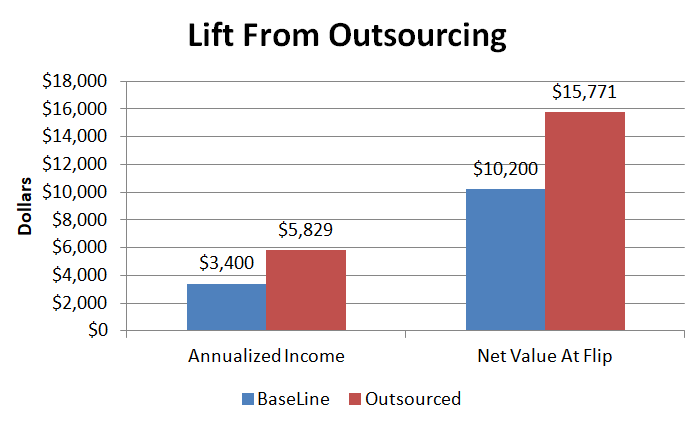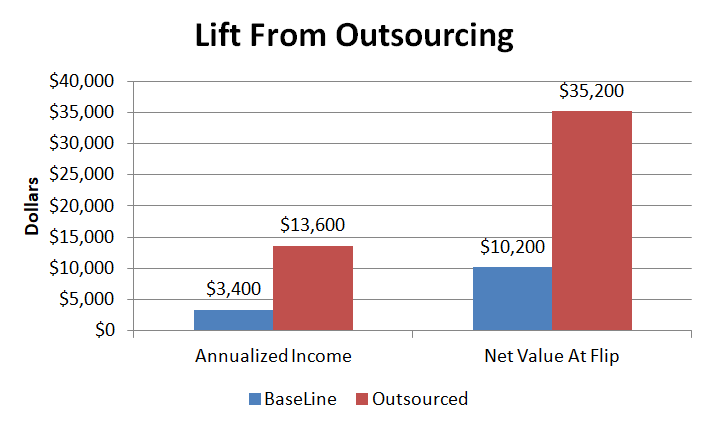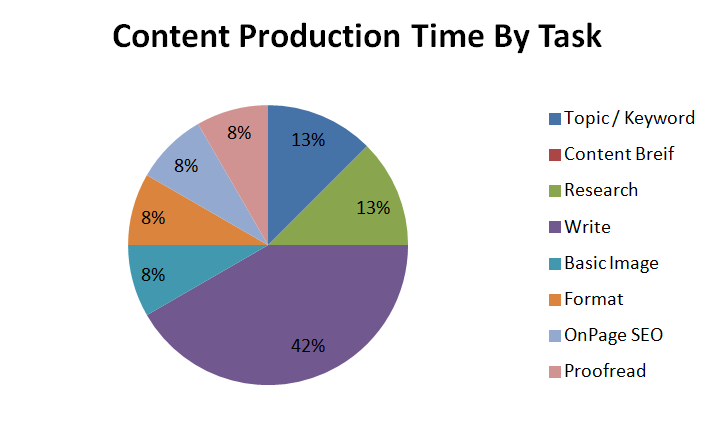I’ll kick off our discussion about how to outsource content writing with a quote. One of my longtime favorite authors, Patrick McKenzie (patio11 on Hacker News), commented on his blog that there was no shortage of people on the internet who would work for $3 an hour. Immediately after which he observed that many were not bargains even at that price.
You get what you pay for.
When it comes to content production, there is no free lunch. While it may not be apparent, you’ve enjoyed some significant productivity advantages as a solo content creator:
- Zero Hand-offs – Everything for the project resides in one brain
- Consistent Quality – You are always you (except before coffee)
- Tolerance for Ambiguity – “Figure it out later” is always an option
- Confidentiality – Trade Secrets are safe (if you don’t brag)
- Free Experiments – I’ll work a few hours “for free” to test an idea…
Newsflash. All of that just went out the window. Hand-offs are the enemy, the birthplace of expensive errors and rework. Writer quality varies widely, sometimes by topic. Everything needs to be specified in advance. You have no protection against writers dumping a quick rewrite onto their own blog (and competing against you). And you’re always burning cash.
Everything you do in this new world burns cash.
Your New Role As An Investor
The good news? You can start to buy revenue growth now, investing cash in lieu of time. This also means you can easily blow a couple grand over the course of an evening with reckless or sloppy purchases. An error which won’t be apparent for a couple of months. With great power, comes great responsibility.

Since we’re investment analysts and process nerds at heart, we’re going to approach the topic from that perspective. This isn’t as crazy as it sounds: you’re about to become a venture capitalist of sorts, funding the development of batches of content in hopes they will produce enough cash to pay back your development costs. You can improve your odds of success using analytics and good processes.
Outsourcing 101: before you do anything, you need to understand what you’re buying. What activities and how much time go into publishing a typical article on your blog?
This is crucial to scaling your business. Remember the iron law of digital publishing:
Ad Revenue > Cost To Create & Promote
There’s a timing issue here as well, since you pay the content creation costs up front and have to wait a few months for these articles to rank on Google and start generating traffic. Given that you have control over costs but not over revenue, we need to get a handle on what we’re trying to buy here…
True Cost of Content: What Are The Parts?
We’ve got a blog full of 500 word articles. How much do we need to spend to publish one more blog post?
You can dial this thought process into any niche, by the way. The same idea works for long posts, videos, and Carrie Bradshaw columns at Vogue ($4 per word!). More on that later.
Here’s my take on what is needed to publish a 500 word article, as written by yours truly. Includes topic identification, researching the top sources for a topic, creating or locating one basic image (public domain, simple chart, or YouTube video), and basic SEO tasks. Should my boss ask me to crank out another 20 posts, this is what I would need…
- Topic / Keyword Selection (8 minutes)
- Create Content Brief (zero, placeholder)
- Research Topic (7 minutes)
- Write Article (25 minutes)
- Find / Make Image (5 minutes)
- Format Post (5 minutes)
- Onpage SEO (5 minutes)
- Proofread (5 minutes)
So basically an hour per post, fully loaded with all the trimmings.
Looking at the chart, it is a mix of activities. About 50% writing time, 25% research and content design, and 25% focused on the tactical logistics of shipping the article. All of which is currently sitting inside the same brain, so we’re not doing any hand-offs…
Capacity Forecast: Content Production
This number is more useful than you think. When things are going well, I can reliably work on our websites for about 15 hours per week. If we assume that 5 hours per week will be consumed with random other stuff (watching ad networks, system issue, site-level testing), that means I can work 10 hours a week on new content. Or a total of 40 hours per month.
So I can crank out 40 new articles per month, assuming they’re all 500 word posts.
This also means I can estimate the future income I’m going to make from all that writing. Since the income from the articles is spread out over time, I will look at this two ways:
- Average monthly earnings per article after 12 months (Year 2 Income)
- Contribution to Website flip value (36 months earnings)
From a practical perspective, I aim to cover total costs within 6 – 12 months and pocket any future money as a bonus. This provides an enormous margin of safety, to say the least.
Some numbers from real websites:
| Topics | Monthly Earnings Per Article | 40 Articles, Year 2 Income | 40 Articles, Flip Value (36 Months) | $$ / Hour (Year 2) |
| Lousy | $1.25 | $600 | $1,800 | $15 |
| Decent | $7.10 | $3,408 | $10,022 | $85 |
| Great | $15.65 | $7,512 | $22,536 | $188 |
Yes, these numbers are real. The latter two results were achieved with better SEO and landing page conversions. There’s a ton of upside in this business once you get a good handle on search engine optimization and affiliate marketing.
Outsourcing Content: Getting Some Help
At this point I feel pretty comfortable I can pick topics at that “decent” level. So we’re going to assume that we can earn $85 per article per year, across a large group of articles. When you go deeper, a large share of the total income is from a handful of articles (big winners). Therefore, we advise executing this strategy in big batches (30+ articles) to increase the odds of getting at least one winner in a wave of content.
Now…. how can we scale this up faster with a little assistance?
Outsourcing the writing comes to mind. How about we try a 4 star author on TextBroker? They should be able to do a solid job without excessive oversight.
- We save 32.5 minutes (writing & topic research)
- We lose 7.5 minutes (creative brief & editing)
- It will cost us about $25
There’s some play in the above based on who you’re working with. My recommendation is to avoid using open orders and contact to 4 star writers with highly relevant experience via private message to assess their interest level. Send the winners a direct order.
Our revised cost structure:

- 35 minutes of my time
- $25 cash cost
Which yields a nice bump in the projected numbers.
- 69 Articles vs. 40 per Month
- $1,700 of Writing Expense
- $2,400 lift in Year 2 Income
- $5,571 lift in “Value at Flip”
Overall, a very attractive opportunity, although not without some risks.
Risks of Outsourcing
So what could go wrong?
My chief concern is a decline in ranking potential and thus earnings, particular since we probably wouldn’t be aware of the problem until we published several months of articles. The model above has us earning $85 per article. We’ve got some room for a decline (on the order of 30%) but would be in serious trouble below that level.
The other challenge, which is more easily detected, is that our writers prove sufficiently difficult to manage that we lose our labor savings. Best usual antidote to this is carefully structured processes which allow the publisher to communicate clearly and efficiently. Writers who can’t operate within these rules need to be ejected from the program.
Plus there’s a tiny chance of weirdness. Writers re-drafting stuff for their blogs, etc. Reverse engineering your SEO. Probably not an issue, but worth keeping an eye on.
Next Level: Outsource Content Management
If outsourcing writing leaves us at 35 minutes per article, how good can we get? It turns out there’s plenty of opportunity remaining. This is where you would need to explore setting up a virtual assistant to handle the administrative side of things.
These 4 tasks, representing 20 minutes of your time, seem ripe for outsourcing:
- Development of the Creative Brief (if given high level direction)
- Part of Proofreading (2/3 of time, assume you skim everything)
- Formatting
- Graphics
The virtual assistant will likely not be as efficient as you, so we need to pad the time up. Assume it costs $10 an hour and doing an article takes the assistant team a full hour. Fortunately, you can hire as many virtual assistants as you require.

This would turbo-charge your growth. Your time investment is 15 minutes per article. Total output would climb to 160 articles per month under these assumptions. You would need at least one virtual assistant and a small platoon of writers. And $5600 per month to fund content. The potential lift is huge, per the attached chart.
My biggest point of caution here would be ensuring quality control doesn’t go completely out the window during this transition. The model looks great at $85 per article of earnings. The economics start to deteriorate around $50 per article of earnings. While the overall operation is profitable, the business doesn’t return cash quickly below that level.
This model also involves a lot more people, who will need to be recruited, managed, and held accountable. While the VA removes a lot of the paperwork associated with managing article development, your touch time on the final product is severely diminished.
Can it work? Probably. You will have a very different business at the end, however.
Results Vary For Other Types of Content
These answers change when we start thinking about other types of content. All of this math was based on 500 word blog posts addressing varied topics with some research. Perhaps there’s a broad theme: business, technology, culture, art – but the story shifts.
Generally speaking, I rate written content projects along three dimensions:
- Volume – sheer word count (keyboard time)
- Depth – required level of original research
- Quality – clarity and creativity in messaging
You can map this to the cost model.
- Writing time usually grows linearly as the word count increases, with some productivity if you can use formulaic content to pad out the essay.
- Research time grows geometrically with requests for deeper insight, unless the writer is already familiar with the field (instant / fast research and higher quality ideas).
- Editing time scale with word count and level of polish required. The latter is jumps when you cut corners on writer quality, relying on the editor to bridge the gap.
- Graphics time scales with the number of images in the piece until you cross the line where public domain and ad-hoc graphics won’t suffice. The cost per piece explodes once you need custom work and photo-shoots.
- Software and Theme modifications are outside the scope of this article but generally behave like graphics; anything which can be addressed via a standard open source package is often quite cheap (or free). Custom code can get heinously expensive.
Tweaking Content Production Economics
One of the chief benefits of understanding the preceding section is you can start to tweak how your content outsourcing process approaches different content types. The big one is controlling research cost, which can explode geometrically, affecting both time and quality.
You should also balance the effort of writing a creative brief (which doesn’t usually change much in response to the length of a piece) with the potential savings from outsourcing the writing tasks. Short articles need to have super-efficient creative briefs for this to work. Along the same lines, outsourcing larger articles is an efficient use of brief writing time.
Getting The Most From Research Time
Given the role the author’s knowledge of the topic plays in both research time and quality of work, I’ve started managing this area especially closely.
Some potential strategies:
- Deep research pieces need either be handled by someone in the field or batched together with similar articles and send to the same author. You need aggressive quality control on these pieces as there is a big time savings from cutting corners.
- Don’t be afraid to downgrade author quality on pieces that don’t require any real research. I’ve had good luck dumping this to 2 star writers at a fraction of the cost. Issue a very explicit creative brief and give them the outline of the desired materials.
Recycling content is an awesome way to get the maximum value from your research effort. Several years ago we did a survey (~20 hours of work) and managed to recycle the results into over a dozen pieces of unique content, several of which got popular on social media.
Content curation is another option, examining a niche and looking for opportunities to aggregate and build off the content of the established players in that space.
Controlling Graphics & Layout Costs
Graphics and layout have their own unique drivers. The key decision point is can the desired feature be accommodated via publicly available sources (free or low cost) vs. custom development. Look for ways to to add these touches systematically via themes, plugins, and simplifying how you buy stock images.
When you do invest in custom development, be ready to leverage the asset as widely as possible in related materials. Make sure the custom feature is critical to the success of the piece (otherwise remove it from the design). Along the same lines, never put a designer in a position where they can dictate your specifications – they almost always go extravagant.
The latter is an example of a broader trend: the natural tension between the creators and the publisher. Content creators, particularly if you publish under their bylines, have a natural incentive to invest in perfection. As a publisher, you’re forced to manage the situations where the economic return from the article can’t fund that level of excellence. Many VC funded digital publishers are struggling with this gap.
Difficult Content – Barrier To Entry
In the spirit of the saying “do things that don’t scale”, don’t be afraid to tackle niches where there are significant barriers to researching or developing good content. Good content can be found at the intersection of good research (idea generation) and good communications. While this isn’t a barrier in many mainstream markets, there are many obscure niches that lack a reliable source who understands both the craft and how describe it.
Don’t be afraid to struggle through building unique capabilities or gaining expertise beyond the remit of mainstream writers. The specifics of this are left as an exercise for the student.
Along the same lines, there is terrific value in achieving an authenticity in a topics which is difficult for a new entrant to replicate. You’ve got an instantly unique voice in that market. This could include unique experiences, unique combinations of skills, or lengthy tenure.
Alternatives to Outsourcing Content
If you’re looking to build steady growth in organic traffic to a set of relatively passively run websites, outsourcing content writing is probably a great strategy. Most of the challenges described above will yield over time to good processes and prudent people management.
That being said, this is not the only way to grow in this space. If you would like to stay solo, here are some potential options that might give you an excellent return.
- Instead of producing a large number of “good” pieces (similar to our example), invest in creating “great” content for higher paying niches. Master SEO and copy writing so you are able to rank higher, integrate affiliate marketing offers, and convert traffic. This is effectively moving up the quality and depth dimensions for a particular niche.
- Explore using paid social, native advertising, and even Google Ads to build volume. Very different model than the one I’m proposing but it works for some people. At a strategic level, this lets you to create an audience on demand (if you can pay for it).
- Look at forums and crowd-sourced content platforms (ratings, discussions). This is an area which has been very silent for a while and there may be new opportunities.
In effect, if you want to stay solo – aim for higher leverage individual contributor positions. Remember that big gap between “decent’ and “great”? Keep pushing for the high side.
